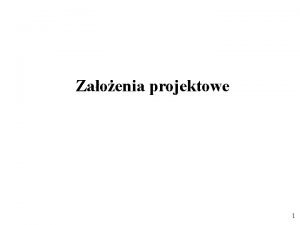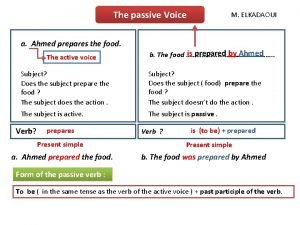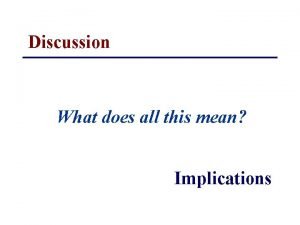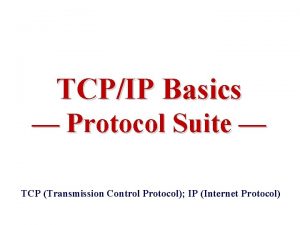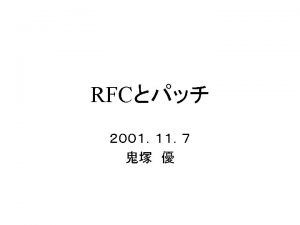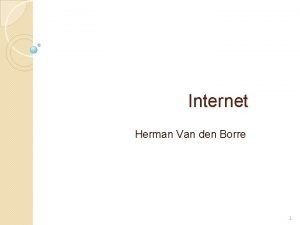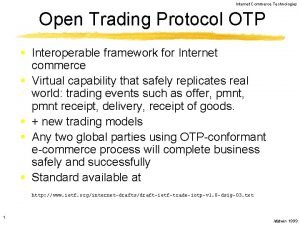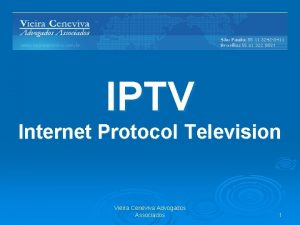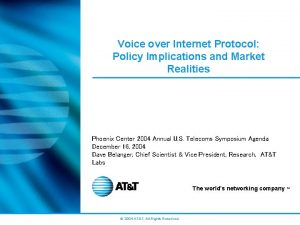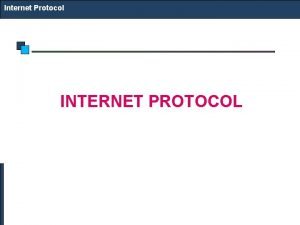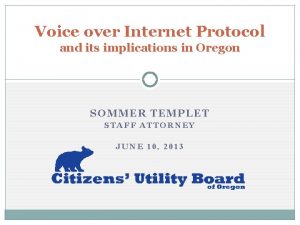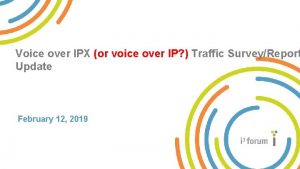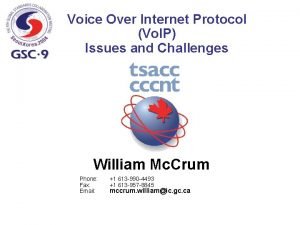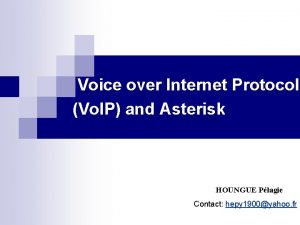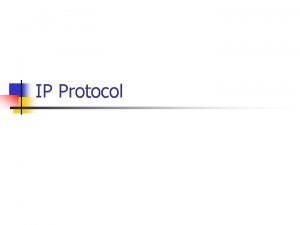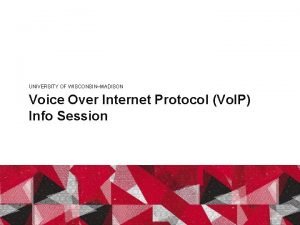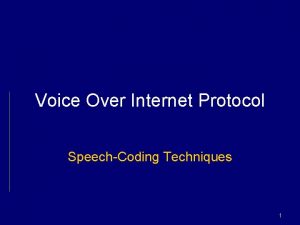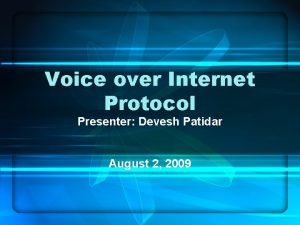Voice over Internet Protocol Policy Implications and Market















- Slides: 15

Voice over Internet Protocol: Policy Implications and Market Realities Phoenix Center 2004 Annual U. S. Telecoms Symposium Agenda December 16, 2004 Dave Belanger, Chief Scientist & Vice President, Research, AT&T Labs The world’s networking company © 2004 AT&T, All Rights Reserved. SM

Vo. IP: A Data Application on an IP Network Enhanced/ Information Services SMTP SIP. . H. 323. . POP 3. . DNS. . HTTP TCP…UDP. . . RTP… IP Traditional Telecom Services (Internet Protocol) Circuit Switched Voice Packet Routed Data Public Phone Network Satellite, Wireless, Cable, Phone, Electric Networks © 2004 AT&T, All Rights Reserved. Logical Layer Voice Physical Layer Internet Protocol (IP) separates applications from the network: • Voice is not longer restricted to telephone networks • Voice becomes another IP data application Domain Video Name Service WWW E-mail Application Layer IP/Internet Applications

The Industry is Making Major Investment: To IP Networks Supporting Real-time Applications like Vo. IP From: Legacy Networks To: Common IP/MPLS Backbone Voice Network The Internet 5 ESS 4 ESS 5 ESS Frame Relay Network Frame/ATM/Voice/IP-VPN Route Servers BX 9000 Private Line Network Route Servers MSE MPLS Core ATM MSE Network Frame/ATM/Voice/IP-VPN Gobal IP Network MPLS: Multi. Protocol Label Switching © 2004 AT&T, All Rights Reserved.

Investment in All Parts of the Network is Essential to Enable Real time IP Applications Data/Communication Networks Worldwide Equipment Investment Estimate Source: Based on data from Prudential Securities Note: Software, network integration, consulting and product support expenditures are expected to match and eventually surpass total equipment expenditures per year. © 2004 AT&T, All Rights Reserved.

Business Priorities Drive Vo. IP Adoption § Rate arbitrage: § TDM origination and termination with IP transport in the WAN § Intra-company calls and faxes on converged network § Emergence of native IP origination environments § Web-based call centers/web callback with IP Enablement § New network-based IP features and services § Converging Local, LD and data § IP enablement of call center features on a converged network Common, Global IP Network Separate Networks Network Convergence © 2004 AT&T, All Rights Reserved.

Vo. IP: A “Killer” IP Application An Information Service that Delivers Voice Communications and Enables Voice Convergence with Other Data Applications and Devices WHAT THE FUTURE HOLDS: • Presence (Instant Messenger, Follow me) • One Number / “Follow Me” Services • Click-to-Talk Interactive Call Centers • Universal Messaging • Virtual Meetings / Collaboration (like Net. Meeting) • Real time language translation • IP Centrex in a Box • Multi-Point Videoconferencing • Desktop Multimedia • Push to Talk Cellular • Voice Chat © 2004 AT&T, All Rights Reserved.

Vo. IP Technical Challenges 1. 2. 3. 4. 5. 6. 7. Network Characteristics Quality of Service Interoperability at the application level (SIP) Security Wireless Global Standards Power and Reliability © 2004 AT&T, All Rights Reserved.

R Factor for Vo. IP R=a-b 1*delay-b 2*(delay-b 3)*H-c 1 -c 2*log(1+c 3*loss) where loss = packet loss percentage for the call delay = one-way end-to-end delay in milliseconds The terms "R-score" and "R-factor" are used to relatency and loss to MOS scores for speech. © 2004 AT&T, All Rights Reserved.

Bandwidth Isn’t Everything Inst Msg Bandwidth (Video) File Transfers Bcast TV Interactive Video Email Bufferability 2 W ay Telephony Thin Client Games 1 W Vo. D Web Browsing ay © 2004 AT&T, All Rights Reserved.

SIP Basics • Session Initiation Protocol (SIP) is a protocol for allowing users to join a “session” for the purposes of exchanging media • Session Initiation • Session Modification • Session Termination • SIP definition is governed by the Internet Engineering Task Force (IETF) • Core of SIP defined in RFC 3261 which supersedes RFC 2543 • SIP is based on “IP Model” • Transport and Application Signaling are separate • Intelligence and state resides in end device (the phone) • SIP is an application signaling protocol • Can use either TCP or UDP as underlying transport protocol • RTP is media protocol • Defines how the media itself (e. g. encoded voice or video) is transported • Uses UDP • Very Important: Media path ≠ Signaling Path © 2004 AT&T, All Rights Reserved.

Vo. IP is Caught in the Middle All we want to do is deliver Vo. IP! Telecom Services Regulation © 2004 AT&T, All Rights Reserved. Computer Application Non-Regulation

Vo. IP Challenges • • Technical Challenges Network Characteristics Quality of Service Interoperability at the application level (SIP) Security Wireless Global Standards Power and Reliability Social Policy Challenges • Numbering • 911 • Law Enforcement Access • Accessibility for the disabled • Consumer protection • Privacy • Consumer choice © 2004 AT&T, All Rights Reserved. Economic Challenges • Intercarrier Compensation • Universal Service Fund • Taxes and fees

Example: Numbering Resources (E. 164 • ENUM numbers): who can get them, and • IETF originally developed ENUM as method for end how can they be used • Most users still want numbers, not SIP addresses! • Potential barrier to market entry and innovation • Location independence/nomadic considerations • Geographic v. non-geographic ranges • Scarcity concerns and strategies © 2004 AT&T, All Rights Reserved. users to provide mapping from E. 164 numbers to Internet resources § Built on top of DNS § Public ENUM is based on end-user opt-in; customer controls Tier 2 name server and records • With network transformation, carrier or infrastructure ENUM becomes more attractive § Supports IP interconnection § Does not require end user opt-in or IPenabled end user § Carrier controls Tier 2 name server and records

Vo. IP Policy Initiatives Continue to Pop Up Numberin g End User Choice of Vo. IP Provider Taxes and Fees Proceedings: UK. Singapore, EU, Germany Intercarrie r Comp FCC Classification USF Emergency Services (911) “CALEA ” Domestic/Int ’l Jurisdiction Consumer Protection © 2004 AT&T, All Rights Reserved. Telecom Rewrite

© 2004 AT&T, All Rights Reserved.
 Voice over internet protocol
Voice over internet protocol Market segmentation lesson plan
Market segmentation lesson plan Leader challenger follower
Leader challenger follower Passive sentence pattern
Passive sentence pattern Active passive voice table
Active passive voice table Actice and passive voice
Actice and passive voice Siach reciting the word over and over
Siach reciting the word over and over Explain how to handing over and taking over the watch
Explain how to handing over and taking over the watch Discussion and implications
Discussion and implications Security architecture for the internet protocol
Security architecture for the internet protocol Internet transport protocol in computer networks
Internet transport protocol in computer networks Dongyang mirae university
Dongyang mirae university Internet official protocol standards
Internet official protocol standards Internet protocol cursus
Internet protocol cursus Iotp
Iotp Iptv internet protocol television
Iptv internet protocol television
